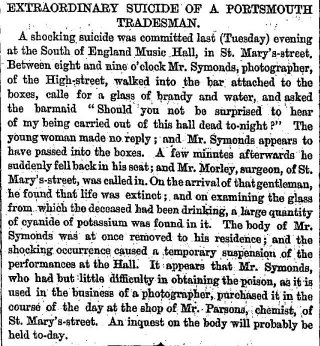
By the mid 1860s photography had become a sophisticated artform and in the forefront of the group of practitioners active in Portsmouth at that time was Symonds and Co. based at 39 High Street, Portsmouth. The head of the company, John Symonds, was undoubtedly a competent and inventive photographer as well as a business man of note. It is perhaps surprising therefore that his career was relatively short, lasting little more than ten years during which he managed to see two, possibly three, businesses lost through bankruptcy.
On his website, Gordon Childs reports some details of the early life of John Symonds. "[He] was born on 25 September 1825 at West Cowes on the Isle of Wight and was baptised the same day at Sun Hill Congregational Church. He was the son of accountant, John Symonds and his second wife Martha Florinda, nee Ratsey who was born in 1797 at Cowes. John was a little older being born c1786..."
"By the time of the 1851 census, John Symonds jnr had married Eliza Warren from Fareham and they had a one year old daughter Kate Eliza who had been born at Cowes. The family was living at Bath Road, Northwood (West Cowes) with John being described as a 25 year old stationer & music seller. By the time of the 1861 census, the family had moved to 15 Union Street, Ryde, where John was now working as a photographer."
By 1865 Symonds and Co. had opened a second office at 39 High Street Portsmouth [Harrod's Directory of 1865], but within a year, on July 18th 1866 he filed for bankruptcy of the Ryde business with liabilities exceeding £1000. A month later the premises at Union Street were put up for sale. They included extensive studios, dark rooms etc. On 24th October 1866 a meeting of creditors was held at the Court of Bankruptcy in London at which point John Symonds declared that he had also run a business in Portsmouth until 1864 and although it still functioned under his name he had no personal involvement in it. This is the only information available concerning an earlier business venture.
The bankruptcy proceedings dragged on for many years. In the Isle of Wight Observer of 27 March 1869 the photographer Richard James stated that he had bought Symonds' bankrupt stock exceeding 10,000 plates of portraits, views, etc and then, on 12th January 1870, a declaration of dividend was issued but by then the Portsmouth company was also in financial trouble.
There is little evidence to explain why Symonds found himself in this situation yet again. In 1865 there were fewer than five photographers in Portsmouth with another half dozen or so in Portsea and Southsea. His main rival would have been RHC Ubsdell whose business was situated a few yards from Symonds' own premises, at No 1 Green Row (now Pembroke Road), but there should have been enough work to go round. It may be relevant that Symonds did not advertise his general services in the Hampshire Telegraph which might be expected if he was hoping to capture the middle and upper class markets. The few adverts he did place in the newspaper related to single events, such as the sale of a painting (7th August 1867) or a prize draw (16th November 1867).

Symonds was not without an adventurous streak and was one of the first photographers to offer stereoscopic prints of local scenes, though he would have had to compete against the widely publicised prints by Ubsdell. He must also have been respected by the military who chose him to record moments of historical importance such as the presentation of colours to the 67th Hampshire Regiment by Lady Buller in August 1868. It may well be that Symonds specialised in local scenes which would be mass produced, rather than portraiture. It is almost certain that he took the well known photograph outside the Dolphin Hotel, looking north along High Street, in 1868, especially as his shop at No. 39 features in it.
In June 1871 Symonds creditors were once more at the door and, presumably, rather than go through another bankruptcy he handed the running of the business over to the principal creditor John Brown of Cowes who installed Richard Donovan as manager. Symonds, his wife and two children continued to live at 39 High Street and though he was permitted to carry out some work on his own behalf he had no control over the business. It was at this time that reports suggested that his consumption of alcohol was having a noticeable affect on his behaviour, though he was rarely seen to be intoxicated. It is not known to what extent his drinking had contributed to the mismanagement of his various businesses.
On Tuesday 1st August 1871 he obtained 100 grains of potassium cyanide which he took to the South of England Music Hall. He mixed it into a glass of brandy which he drank, alone in a box above the stage, dying almost immediately.
On the 9th August 1871 the Hampshire Telegraph reported the proceedings of the inquest which had taken place the previous Thursday at The Dolphin before W.H. Garrington Esq.

It was established by examination of Richard Donovan that the deceased had handed over the business some six weeks previously. John Symonds had no control over any money, even his own, though he was allowed to come and go as he pleased and even took 'some likenesses', the fees for which were handed over to his wife Eliza. This arrangement had been agreed by all parties on account of Symonds' intemperate habits.
The Coroner pressed Donovan for a more detailed opinion of Symonds' drinking which, he said, seemed to result from depression [possibly as a result of the loss of three businesses within the past ten years]. Even so, though Symonds took drink regularly, he was not seen to be intoxicated. His family, meanwhile, stood by him whilst his wife would often give him some money knowing that he would spend it on alcohol. Donovan thought that 'all energy in him [Symonds] was gradually dying out' but that he was 'a man of fine business qualities'.
On the day that Symonds committed suicide he had taken his sister to visit St. Thomas's Church, from the tower of which he had been taking photographs but later he left the house without asking his wife for money or saying where he was going.
Mr. George Frederick Symonds, son of the deceased, said he had never heard of his father speak of taking cyanide of potassium. He had often spoken of death in various shapes and said he thought drowning was the easiest. The witness was more concerned that his father would harm his mother rather than himself. Mr. William Parsons, chemist of St. Mary's Street said that John Symonds had called at his shop of the day of the suicide and asked for an ounce of cyanide of potassium. This was not unusual given it's usage in the photographic trade, and Symonds seemed not at all peculiar.
Jane Gerard, barmaid at the South of England Music Hall said that the deceased was in the habit of coming to the hall. She had seen him intoxicated but not often. Shortly after seven on the day he died Symonds came to her bar and said "Would you be surprised if I was to go out of the Hall alive tonight" to which she replied, "I should be still more surprised if you were taken out dead". He was then supplied with six-penny worth of brandy which he shortly took to the box over the stage. He was seen there on several occasions by the box-keeper, Thomas Wilkinson, who remarked that he was alone and smoking a pipe. About a quarter past eight Wilkinson observed that Symonds was looking "ashy pale" and not liking his appearance, arranged to have him taken out of the box onto the landing. His opinion was that Symonds was already dead.
A waiter at the Hall, Thomas Garnett of 21 Landport Street said he had attended the deceased in the box and that after he had been removed took a small glass from the box in which there was a little liquid and what appeared to be undissolved sugar. Mr. Frederick Morgan, surgeon of 43, St. Mary's Street was called. He declared that Symonds was dead and ordered the corpse to be taken home.
The Coroner concluded that death had been caused by the intake of cyanide of potassium and the jury were in favour of a verdict to the effect that the deceased committed suicide while in an unsound state of mind.
Tim Backhouse
POSTSCRIPT
Both sons of John Symonds, George and Harry, followed in their father's footsteps and became photographers; marrying and raising families in Portsmouth.
REFERENCES
Hampshire Telegraph
www.iowphotos.info
John Sadden (Copy of stereoscopic image)